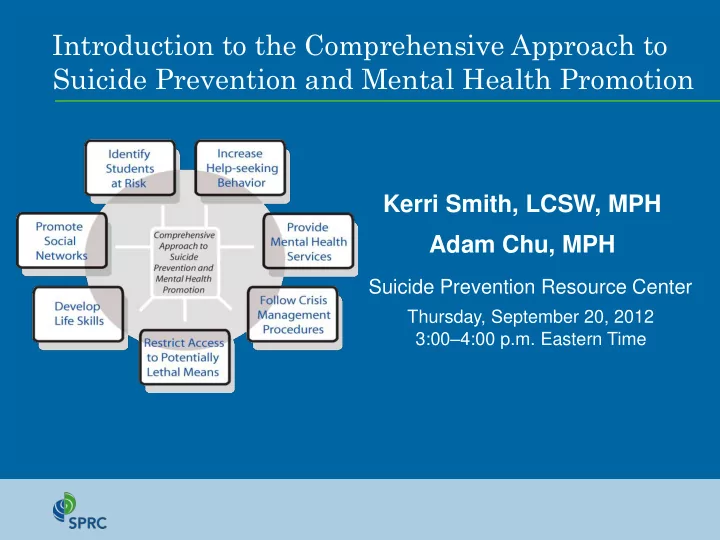

Introduction to the Comprehensive Approach to Suicide Prevention and Mental Health Promotion Kerri Smith, LCSW, MPH Adam Chu, MPH Suicide Prevention Resource Center Thursday, September 20, 2012 3:00 – 4:00 p.m. Eastern Time
Who you’ll hear from today Kerri Smith Adam Chu Senior Campus Prevention Specialist Prevention Specialist
Before we begin… If you are having any technical problems joining the webinar please call 617-618-2380 or Adobe Connect 1- 800-422-3623. Type any questions or comments at anytime into the text box on the lower left hand side of your screen and we will attempt to assist you.
Agenda SPRC/Jed Foundation Comprehensive Approach to Suicide Prevention and Mental Health Promotion Examples of how other campuses have adopted a comprehensive approach Identify current strengths and gaps on your campus for implementing a comprehensive suicide prevention program
What is one part of your program that you are excited to begin work on?
Public Health Approach Problems occur at multiple levels Individual Interpersonal Institutional Community Society Based on DeJong & Langford, 2002
TJF/SPRC Comprehensive Approach Intervene at multiple levels with multiple, integrated strategies The Jed Foundation; Suicide Prevention Resource Center
Identify Students at Risk Goal: • Identify those students who may have mental health problems, be at risk for mental health problems, or be at risk for suicide.
Identify Students at Risk
Increase Help-Seeking Behaviors Goal: • Increase the likelihood that a student who needs supportive services or counseling will seek out and secure assistance.
Example: University of Wisconsin- Oshkosh
What barriers to help-seeking exist on your campus?
Increase Access to Mental Health Services Goals: • Ensure that students who need services receive them. • Ensure services are appropriate and of high quality. • Assess and manage suicide risk.
Follow Crisis Management Procedures Goals: • Respond effectively to students who are acutely distressed or suicidal. • Help survivors deal with grief and confusion, and to prevent suicide contagion when a suicide does occur.
TJF Framework for Developing Institutional Protocols http://www.jedfoundation.org/professionals/programs-and-research/framework
Questions?
Restrict Access to Lethal Means Goal: • To limit access to potential sites, weapons, and other agents that may facilitate dying by suicide
Restrict Access to Lethal Means Cornell University Bridge Barriers NYU Bobst Library
Other ways campuses can restrict access to lethal means?
Develop Life Skills Goal: • To promote the development of skills that will assist students as they face various challenges in school and in life
What do you think?
Other ways this campus could promote the development of stress management skills?
Promote Social Networks Goal: • To promote relationship- building between students, staff, and faculty and a sense of community on campus
Example: WPI’s Student Support Network
Questions?
Are you ready?
Activity Current strengths Gaps to be addressed Steps to address gaps
Discussion
What Alumni Grantees are Saying… “Collaboration with other “Don’t do it alone!” campuses is extremely valuable: shared ideas, shared perspective, shared goals.” “Find out what campus partners need and make your program work for them. Help them to see this as a resource.”
Your SPRC Prevention Specialists Kerri Smith, LCSW, MPH Sheila Krishnan, MPH Senior Campus Prevention Campus Prevention Specialist Specialist ksmith@edc.org skrishnan@edc.org 617-618-2738 202-572-3761 Cohort 6 Assignments: Cohort 6 Assignments: - Delta State University - Bowling Green State - George Mason University University - Montgomery College - Medical Univ. of South - Oakland University Carolina - Pensacola State - Miami University - Saginaw Valley State - Niagara County Community University College - Tarrant County College - Oglala Lakota College District - Temple University - Texas Christian University - Trustees of Amherst College - University of CA- Davis - University of Florida - Wartburg College - University of WI – Madison - University of Iowa - University of WI - Milwaukee
Your SPRC Prevention Specialists Adam Chu, MPH Julie Ebin, M.Ed Smita Varia, MA Prevention Specialist Senior Prevention Specialist Prevention Specialist achu@edc.org jebin@edc.org svaria@edc.org 202-572-3718 617-618-2947 617-618-2257 Cohort 6 Assignments: Cohort 6 Assignments: Cohort 6 Assignments: - California State - Bergen Community - Chaminade University of Northridge College Honolulu - North Carolina State - CSU Sacramento - Miami Dade College - Century College - Monmouth University University - Purdue University – Ft. - Three Rivers Community Wayne College - University of AL in - University of Hawaii at Hilo Huntsville
Your SPRC Prevention Specialists Elly Stout, MS Prevention Support Program Manager estout@edc.org Gayle Jaffe, MSW, MPH 617-618-2206 Senior Prevention Specialist gjaffe@edc.org 202-572-3773 Cohort 6 Assignments: - College of William and Mary - Plymouth State University Cohort 6 Assignments: - Salisbury University - University of Tennessee- - University of MA - Lowell Martin
What’s Next? Exercise: Inventory of programs, policies and services on your campus Webinar: Strategic Planning Principles Thursday, October 4 th , 3-4pm ET
Final Questions?
Thank ank you! This webinar will be posted on SPRC’s website at: www.sprc.org/grantees/grantees-technical- assistance-meetings-and-webinars
Recommend
More recommend